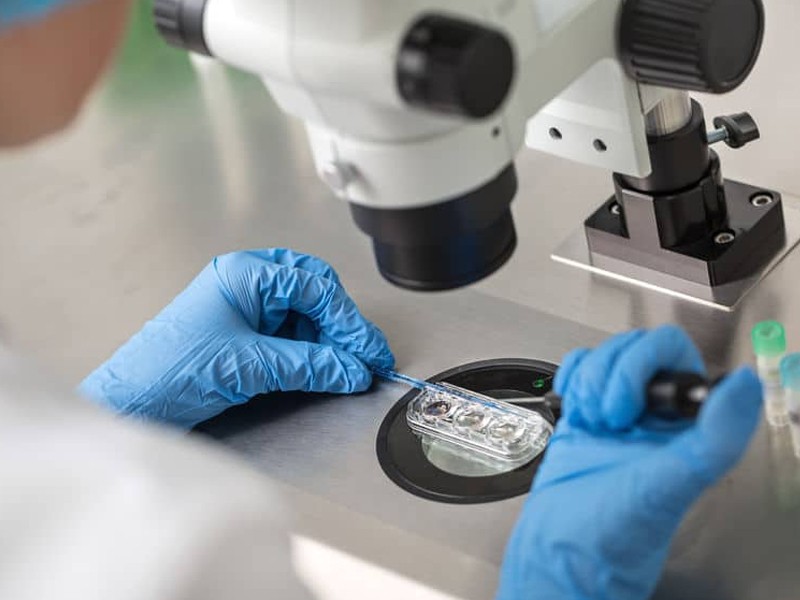Obstruction of fallopian tubes. What are these reasons, how to fight and how to prevent them?

The fallopian tubes are a paired tubular organ of the reproductive system that connects uterus and ovaries.On average, the pipe channel diameter is 0.1mm, and length is 10-12 cm. In them, sperm meets the egg, where fertilization takes place. After that, a fertilized egg passes through the tube into the uterine cavity and attaches itself to its wall. Movement is provided by special villi that are located on the mucous membrane of each tube. Thus, fallopian tubes are directly involved in fertilization.
But, through various diseases and pathologies, patency of tubes can be impaired.
What is Fallopian Tube Obstruction?
Obstruction of the fallopian tubes is a pathological condition characterized by a decrease or complete absence of lumen of the fallopian tube. Thus, fertilization cannot take place. According to various statistics, from 20% to 60% of obstructions cause female infertility, as well as 6-10% – ectopic or tubal pregnancy.
Most often, women may not be aware of development of disease. After all, she does not have any special symptoms, and sometimes the only complaint is infertility. Therefore, it is so important to undergo preventive examinations and consult a doctor before conception.
But there are still several non-specific symptoms:
- Painful menstrual period;
- Pain at rest, not associated with menstruation or during sex;
- Possible discharge of Irregular character with an unpleasant odor;
- Lack of pregnancy during a long period of active sex life without contraception.
Why is there obstruction of the fallopian tubes?
In general, there are many reasons that lead to this disease.
Let’s take a closer look at the most common ones:
- Anatomical disorders of the development of fallopian tubes, congenital malformations of the reproductive system, polyposis, oncological neoplasms.
- Chronic inflammatory processes of fallopian tubes. During inflammation of the mucous membrane of the fallopian tube, it can stick together and thus completely block lumen. And also they can damage the villous layer of the tube, and also makes it impossible for egg and sperm to move along it.
- Endometriosis. A disease in which the outer layer of the uterine lining grows beyond its limits. If it grows towards the fallopian tubes, then it can block it.
- Postponed tubal pregnancy. This happens when a fertilized egg attaches to the fallopian tube rather than to the uterine cavity. After this State, the lumen of the pipe can be reduced or completely closed.
- Adhesions. Connective tissue fibers that can form after surgical interventions on the abdominal organs (intestines, uterus, tubes, ovaries, etc.), after an abortion or diagnostic curettage of the uterus.
All these reasons can lead to partial or complete occlusion of the lumen of the fallopian tubes. And only a good diagnosis can reveal this pathology.
How is Fallopian Tubal Obstruction Diagnosed?
At the moment in medicine, there are several instrumental methods for diagnosing the patency of the fallopian tubes.
- Hysterosalpingography. During this study, a contrast agent is injected into the uterine cavity and then an x-ray is taken. If the image shows a contrast agent in the abdominal cavity, then we can say that the fallopian tubes are patent. But if the tubes are not filled or half full, an obstruction is diagnosed.
- Hydrosonography. With the help of a catheter, saline is injected into the uterine cavity, which moves through the fallopian tubes into the abdominal cavity. Due to the fact that the density of the solution and the walls of the uterus is different, the doctor can use ultrasound to observe its movement. If the pipe is blocked, he will see that it expands in volume.
- Laparoscopic method. This is a minimally invasive surgical technique in which a camera is inserted into the abdominal cavity, and a dye is filled into the uterus. After a few minutes, the doctor in the chamber can observe the outflow of the dye into the abdominal cavity, and will indicate patency. Also, during this method, the doctor can immediately start treating the obstruction.
Each of the diagnostic methods is selected individually for a specific patient. After establishing the diagnosis and the cause of the obstruction, the doctor prescribes treatment.
How to deal with obstruction of the fallopian tubes?
Depending on the cause, extent and complexity of the disease, the doctor may plan a conservative treatment or surgery.
Conservative treatment. It is used for inflammatory processes in the tubes. Physician Prescribes Anti-Inflammatory Drugs, Antibacterials, and procedures to improve local blood circulation.
Surgical method. Most often, it is a Laparoscopic Intervention, during which the cause of the obstruction is directly eliminated: dissection and removal of adhesions, removal of polyps and neoplasms, etc. Also, plastic surgery of the fallopian tubes can be performed if there are anatomical abnormalities.
But there are times when the obstruction of the fallopian tubes cannot be cured or there is a question about the removal of both fallopian tubes. For example, this happens with a running inflammatory process, recipient polyposis, or cancer.
In this case, it is worth using assisted reproductive technologies, in vitro fertilization or ICSI. During this method, fertilization occurs outside the woman’s body and then a full-fledged embryo is implanted into the uterus, which is then attached to its wall. Thus, the stage of fertilization in the fallopian tubes is bypassed.
Treatment methods can be chosen only by a doctor, taking into account the condition of the woman and the stage of the process.
How to prevent obstruction of pipes?
It has long been recognized in medicine that it is much easier and cheaper to prevent the disease, rather than treat the consequences. It is the same with obstruction of the fallopian tubes.
By following simple preventive tips, you can prevent illness:
- Regular preventive examinations by a gynecologist. Once a year, for women under 35 years old, and once every 6 months after 35 years. Often, in the early stages, the obstruction can be treated conservatively.
- Do not self-medicate genital inflammatory processes. This can lead to a transition to a chronic state and further contribute to the closure of the lumen of the fallopian tubes. It is better to consult a doctor in time and under his supervision to be treated.
- Use barrier methods of contraception with new sexual partners. It will significantly reduce the chance of transmission of sexually transmitted diseases.
- Avoid abortion. Very often, abortions lead to inflammatory processes in the uterus and tubes, the development of endometriosis and other diseases, which in the future can provoke obstruction of the fallopian tubes. It is recommended that abortions be carried out only for medical reasons.


